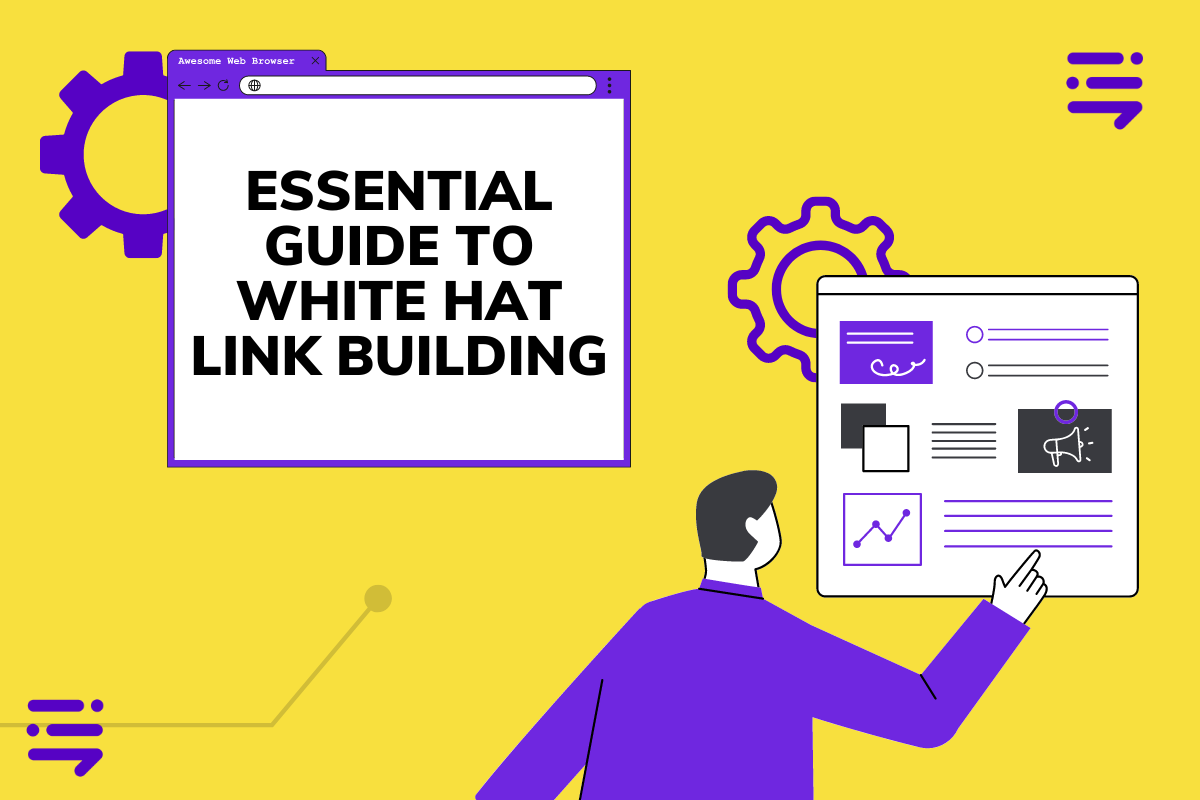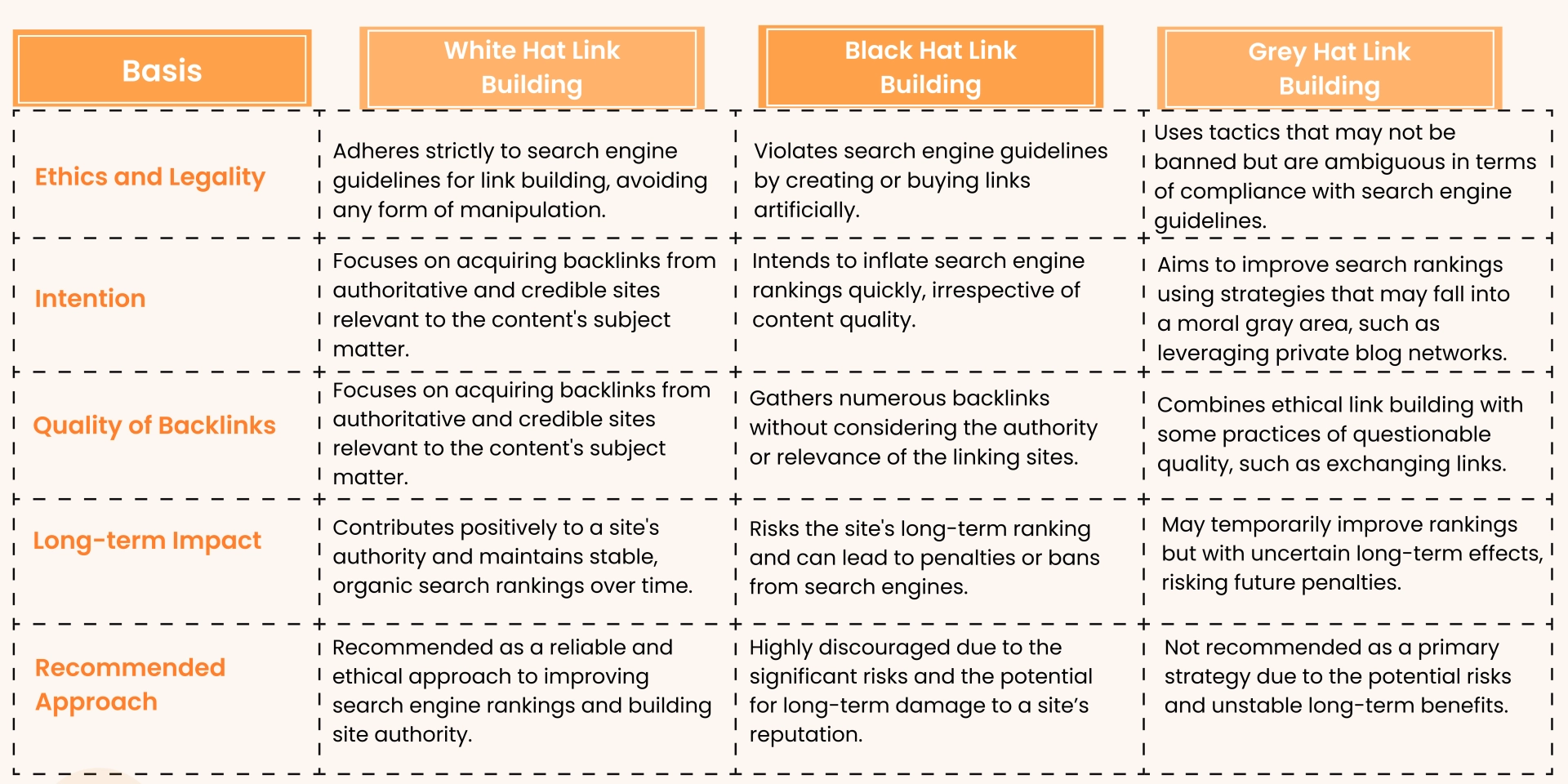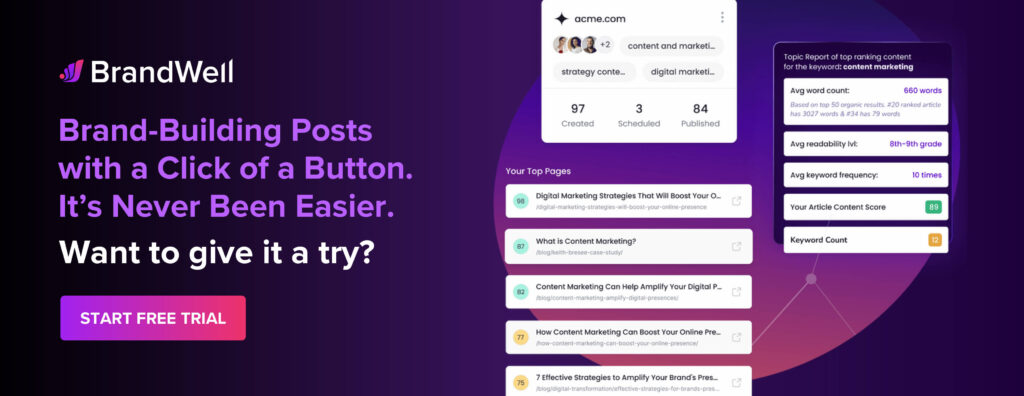Discover top guides, trends, tips and expertise from AIO Writers

So, you’ve heard about white hat link building and its power in the SEO world. Well, it’s time we got into why this method stands out. Unlike quick fixes that crash and burn, white hat strategies promise growth that sticks.
The journey towards mastering white hat link building is more like preparing a gourmet meal rather than microwaving instant noodles. It requires patience, precision, and understanding the recipe for success — quality content paired with genuine outreach.
And guess what? All that hard work really draws in the crowd naturally. We’re not just trying to stay on Google’s good side; we aim to build an online identity that stands the test of time.
Let’s break down what is white hat link building — how it’s different from black hat techniques, why it is the preferred link-building strategy, and how to implement it in your marketing plan.
Table Of Contents:
- What is White Hat Link Building?
- Top 5 White Hat Link-Building Techniques
- White Hat Link Building Best Practices
- Essential Tools for White Hat Link Builders
- Measuring the Success of Your White Hat Link-Building Efforts
- FAQs – White Hat Link Building
- Conclusion
What is White Hat Link Building?
White hat link building is the process of acquiring high-quality, relevant backlinks to your website in an ethical manner that adheres to search engine guidelines. It’s the opposite of black hat link building, which involves manipulative tactics that can get your site penalized.
Benefits of White Hat Link Building
So why bother with white hat link building? For starters, it can help improve your search engine rankings. When other reputable websites link to your content, it signals to Google that your site is trustworthy and valuable.
But the benefits don’t stop there. White hat link building can also drive targeted referral traffic to your site, increase brand awareness, and establish you as an authority in your industry. It’s a smart move for the long haul that keeps your site safe from any nasty penalties.
White Hat vs. Black Hat Link Building Strategies
White hat techniques focus on creating high-quality content that naturally attracts links. You might think about writing guest posts for websites that catch your eye, hunting down those pesky broken links to fix, or putting together some awesome infographics and guides that everyone loves.
Black hat techniques, on the other hand, involve manipulative tactics like buying links, using link farms, or hiding links in sneaky places like the footer of a website. These tactics might give you a temporary boost in rankings, but they’ll likely catch up to you eventually in the form of a manual penalty or algorithmic downgrade.

Top 5 White Hat Link-Building Techniques
Now that you know the basics of white hat link building, let’s dive into some specific techniques you can use to start building high-quality links to your site.
1. Guest Posting
Guest posting involves writing content for another website in your industry in exchange for a link back to your own site. This approach is a fantastic strategy for showcasing your work to new folks while also forging solid connections with fellow website owners.
To find guest posting opportunities, try searching for phrases like “write for us” or “guest post guidelines” along with your niche keywords. You can also use tools like Ahrefs Content Explorer to find sites that have published guest posts in the past.
“Guest posting is a two-way street. In addition to posting content to other blogs, invite people in your niche to blog on your own site. They’re likely to share and link to their guest article, which could bring new readers to your site. And allowing others to post on your blog helps you build relationships with other experts in your field.” – Rand Fishkin, Founder of Moz
2. Broken Link Building
Broken link building involves finding broken links on other websites, creating content that would be a good replacement for the broken link, and reaching out to the site owner to let them know about the broken link and suggest your content as a replacement.
To find broken link building opportunities, you can use tools like Ahrefs Broken Link Checker. Once you’ve found a broken link, create a piece of content that would be a good fit for the linking page, and reach out to the site owner to let them know about the broken link and suggest your content as a replacement.
3. Create Link-Worthy Content
One of the best ways to attract high-quality links is to create content that other people will want to link to naturally. This could include things like:
- Original research or data
- Comprehensive guides or tutorials
- Infographics or other visual assets
- Interactive tools or calculators
The trick lies in whipping up something genuinely useful for your audience and serving it in a format that’s both captivating and simple to get. By doing so, you’ll naturally attract links from other sites in your industry.
4. Digital PR Outreach
Digital PR involves reaching out to journalists, bloggers, and other influencers in your industry to get your content featured on their sites. This could involve things like:
- Pitching guest post ideas
- Offering expert quotes or insights for a story
- Sharing original research or data that might be of interest to their audience
The key to successful digital PR outreach is to focus on building genuine relationships with influencers in your industry. Don’t just reach out when you need something — take the time to engage with their content, share their work, and offer value before making an ask.
5. Reclaiming Unlinked Brand Mentions
Finally, one often-overlooked white hat link building technique is reclaiming unlinked brand mentions. This involves finding instances where your brand is mentioned on other websites without a link and reaching out to the site owner to request that they add a link to your site.
To find unlinked brand mentions, you can use tools like Mention or Google Alerts to track mentions of your brand across the web. When you find an unlinked mention, reach out to the site owner with a friendly email letting them know you appreciate the mention and politely asking if they’d be willing to add a link to your site.

White Hat Link Building Best Practices
Alright, you’ve got a solid understanding of white hat link-building techniques. But how do you actually put them into practice? Here are a few key strategies to keep in mind.
Build Relationships with Content Creators
At its core, white hat link-building is all about building genuine relationships with other content creators in your industry. It’s all about rolling up your sleeves and getting involved with what they’re putting out there, from sharing their posts to showing some love for their work, long before you even think of hitting them up for a link.
One great way to build relationships is to start by creating a list of influencers and content creators in your niche. Follow them on social media, subscribe to their newsletters, and regularly engage with their content by leaving thoughtful comments and sharing their work.
Think of link building as putting your money where your heart is, focusing on forging strong, lasting connections. If you’re only focused on getting the link, you’re doing it wrong. The best link building strategies are those that focus on providing value, building trust, and establishing genuine connections with others in your industry.” – Julie Joyce, Link Building Expert
Adhere to Search Engine Guidelines
When executing any link-building strategy, it’s crucial to make sure you’re adhering to search engine guidelines. This means avoiding any manipulative or spammy tactics that could get your site penalized.
Some key things to keep in mind:
- Focus on creating high-quality, valuable content that other people will want to link to naturally
- Avoid buying links or participating in link schemes
- Use descriptive, relevant anchor text when linking to other sites (avoid generic phrases like “click here”)
- Disavow any low-quality or spammy links pointing to your site
Focus on Quality Over Quantity
At the end of the day, if you’re diving into white hat link building, remember it’s more about snagging those top-notch links rather than hoarding a bunch of them. A handful of high-quality, relevant backlinks from authoritative sites in your industry will be much more valuable than dozens of low-quality links from spammy or irrelevant sites.
Some key things to look for when evaluating the quality of a potential linking site:
- Relevance: Is the site relevant to your industry or niche?
- Authority: Does the site have a strong domain authority and backlink profile?
- Traffic: Does the site get a significant amount of traffic?
- Engagement: Does the site have an engaged audience that regularly shares and links to its content?
Putting effort into connecting with reputable websites and crafting content that genuinely helps your audience can lead you to draw in the type of links that boost your site’s visibility and bring more focused traffic gradually.
Essential Tools for White Hat Link Builders
You’ve got your white hat link-building strategy all mapped out. But now you need the right tools to make it happen.
Here are some essential tools every white hat link builder needs in their arsenal:
Backlink Analysis Tools
First up, you need a reliable backlink analysis tool. These tools help you assess your current backlink profile, identify opportunities for improvement, and keep tabs on your competitors’ link-building strategies.
Some of the best options for competitor backlink analysis include Ahrefs, Moz, and Semrush. With these in your toolkit, you’ll be able to see exactly where your backlinks are coming from and how they stack up against the competition.
Content Ideation Tools
Next, you need some solid content ideation tools. These will help you discover popular topics, questions, and content formats in your industry, inspiring you to create link-worthy content assets.
Some of my favorites are BuzzSumo, AnswerThePublic, and Google Trends. Use these to find out what your audience is searching for and what types of content are getting the most engagement.
Outreach Management Platforms
Finally, you’ll want an outreach management platform to streamline your link-building email outreach process. These tools help you find contact information, personalize emails at scale, and track your outreach campaigns’ success.
BuzzStream, Pitchbox, and Hunter.io are all great options. With these in your corner, you’ll be able to build relationships with content creators and land those valuable backlinks with ease.
Measuring the Success of Your White Hat Link-Building Efforts
You’ve put in the hard work, used the right tools, and executed your white hat link-building strategy like a pro. But how do you know if it’s actually working?
Here’s how to measure the success of your efforts:
Track Organic Traffic Growth
One of the best ways to see if your link building is paying off is to track your organic traffic growth. Use a tool like Google Analytics to monitor how many visitors are coming to your site from search engines.
If you see a steady increase in organic traffic over time, that’s a good sign that your link-building efforts are improving your search engine visibility and attracting more targeted visitors to your site.
Monitor Referring Domain Metrics
Another key metric to watch is the number and quality of referring domains linking to your website. Use your backlink analysis tools to track the growth in unique referring domains and keep an eye on their Domain Authority or Domain Rating.
If you’re seeing an increase in high-quality, relevant domains linking to your site, that’s a strong indication that your white hat link-building techniques are working.
Evaluating Website Authority Improvements
Finally, take a look at your website’s overall authority metrics. Tools like Moz’s Domain Authority, Ahrefs’ Domain Rating, and Majestic’s Trust Flow can give you a sense of how strong and trustworthy your site appears in the eyes of search engines.
As you earn more high-quality backlinks, these metrics should increase over time, signaling that your white hat link-building efforts are paying off and boosting your site’s authority.
FAQs – White Hat Link Building
What is white hat link building?
It’s the practice of getting backlinks through ethical, Google-approved methods. It boosts your SEO without gaming the system.
What is the difference between white hat and black hat backlinks?
White hat links follow search engine rules; black hat ones don’t, risking penalties. Think quality over trickery.
Is link building illegal?
Nope, but there’s a catch. Stick to legit strategies like guest posting or content creation to stay in Google’s good side.
What is black hat link building?
This sneaky tactic tries to fool search engines for a quick rankings boost but can get your site penalized fast.
Conclusion
White hat link building is a strategy that isn’t just good on paper — it’s essential for anyone looking to build sustainable web traffic without falling foul of search engine rules.
Sure, taking shortcuts might seem tempting but remember, the tortoise won in that famous race because he understood value over speed. White hat link building promises not only better rankings but also respect from both search engines and users alike.

UNLOCK YOUR POTENTIAL
Long Headline that highlights Value Proposition of Lead Magnet
Grab a front row seat to our video masterclasses, interviews, case studies, tutorials, and guides.



